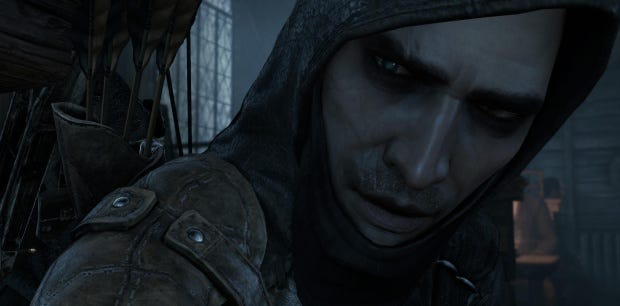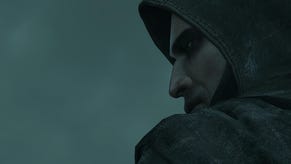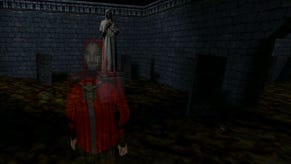Wot I Think: Thief
Pinch me
It's been a very long time coming, first confirmed in 2009, but the new Thief is out this week. Tomorrow in the States, Thursday in Australia, and Friday in Europe. Having just managed to get a copy of the game in time, I've done nothing but play Thief for three days in order to be able to tell you wot I think:
Oh thank God. It’s good.
While there's going to be controversy, I'm arguing that it’s better than good. Thief, Eidos Montreal’s reviving of Looking Glass’s insurmountable series, is a superb game. It’s a tangible relief to write that. After years of really awful publicity, terrible press demos, and trailer after trailer of schlocky crap, our hopes were below waist level. But cast it all aside and chalk it up to abysmal marketing. While there is much to pick at, and I am certain there will be many who are apoplectic in their outrage, as a game within itself, Thief is bloody great.
As the fourth in what I suspect might be the best trilogy in all of gaming, previously from the best development studio that ever existed, yeah - it suffers a bit more there. That’s the Thief dilemma, right there. Eidos Montreal following up Deus Ex, arguably the best ever PC game, was a bold move. Following arguably the best ever PC gaming trilogy was truly gutsy. They weren’t ever going to better it, I don’t think. Neither Thief: The Dark Project’s genre-creating wonderment, nor Thief: Deadly Shadows’ astonishing terror and storytelling, were targets that seemed expectable. And yes, it falls short of them. But damn if it doesn’t get close in places.
Let’s get the worst of it out of the way: the story is incomprehensible shit. Pathetically, rather than Garrett’s previous wonderful self-driven motives, this time he’s avenging a girl. No, seriously. At the start he’s accompanied by an impetuous young scamp who insists on killing people rather than politely clonking them unconscious, and takes dumb risks. One such dumb risk sees her get in rather a lot of trouble, and from then on, depressingly, it’s her stupidity that acts as the motivation for Garrett’s pursuit of those trying to corrupt the City.
There are approximately four hundred and seventy-three baddies in the game, all linked by some nonsense about some magic stones and a disease called GLOOM, wandering in and out of the plot like lost pensioners. So much is set up and then never delivered upon, threads fray and go welcomely forgotten, and what’s there is bearded men shouting about power or their desire for it. Utter, utter bilge, horribly written, and a massively wasted opportunity to do something new or interesting with Garrett’s world. Fortunately, it matters very little, since it’s only there as an excuse to link epic, intricate and hugely enjoyable levels together.
It’s a big game. The game’s own clock records 22 hours, and that sounds right to me. Most missions took me at least an hour, some as long as an hour and a half, and many of the thirty or so side-quests (yes, thirty!) take between ten minutes and half an hour. And then there’s time spent creeping around the absolutely enormous city, exploring, trotting between fences and mission givers, or trying to fathom routes to various walkways in order to break into a tempting looking house. It’s big in a way first-person games haven’t been big in a very long time.
And it’s big within those missions, too. Each of the eight or so core chapters is set in a unique location, of stunning architecture and daunting scale. While there aren’t nearly as many alternative routes through some levels as the game clearly wants you to think there are, and often the funnelling can be a little too apparent, you’re still freely exploring enormous mansions, plazas and cityscapes. Each level is packed with vast amounts of loot to pilfer, lots of it hidden behind mini-challenges for the keen of eye, as well as all manner of collect-me-do special bits and pieces to incentivise you to replay and get the lot.
The detail is just exceptional. While character faces are oddly poor and repetitive, and lip-syncing is all over the place, the buildings and rooms are lavishly crafted. Each significant room within a massive complex feels unique and precisely crafted to tell the story of the person who may occupy it. It’s almost beyond compare, just how much care has gone into the location design, and it’s crucial stuff in a game where you’ll spend an awful lot of time crouched in a corner, waiting for your moment.
Accompanying this level of detail is the level of effort put into side quests. There are two characters within the city who will give you a series of optional quests to complete, each with their own (anticlimactic – see above) story, which offer a lovely level of depth and detail to distract you for a couple of hours each. And then there’s a remarkable 24 further mini-missions, scattered about the city, offering a little unique challenge each. The only issue with these latter tasks is that – unless I did something wrong that I’m unable to figure out – they didn’t become available until the final third of the game. That’s incredibly strange, and a shame, as it would have nicely fleshed out the long, long journeys around the streets.
So, terrible story, great missions. But what about the thiefiness of Thief? This is where it will get controversial. Blimey, just rope arrows will probably be enough to cause a schism in the gaming world that will lead to civil war.
Garrett’s movement is going to piss a lot of people off. It pissed me off too, until I grew used to it, and then only when it didn’t work properly. Garrett, you see, doesn’t have a proper jump button.
(...)
Calmed down yet? Rather than proper free movement that he obviously should have had, instead Thief embraces this ugly trend for contextualised movement. So spacebar, for most of the time, is used for “Swoop”. Now, let’s be clear, Swoop is the acing best. It glides you forward, over a short distance, in a way that lets you – well – swoop into hiding in moments of panic. Or just sweeping your way up flights of stairs because it makes you feel great. It’s not quite Dishonored’s ‘blink’, but it’s close.
But it will jump when you’re in front of a gap the game deems suitable to be jumped. Or climb where the game has designated climbing. And this is, without doubt, the biggest disappointment in the game. It survives it – it’s crucial to know that – but I was gutted. Figuring out routes across rooftops and up the sides of buildings is more fun the more free you are, and in Thief, a lot of that freedom is taken away. As such, you end up with dumb gimmicks like paint splooshes and scratches on climbable obstacles, and recognisable traits to jumpable gaps. Fortunately, of each there are billions, so there’s no shortage of climbing and jumping – and indeed it’s still possible to jump to your death – but, still.
This became much less of a problem for me the further I got. Accepting the system and working within it is pretty much the core of gaming itself, and there’s enough variation and opportunity here for it to almost get away with it. Almost. There are far too often obstacles that a toddler could easily scale, but Garrett won’t even try, and his refusing to jump certain gaps in order to force a challenge is maddening. THE WINDOW IS RIGHT THERE! JUST JUMP! But no, the game has a different route in mind. I’m certain some will bounce straight off Thief because of this, and I think it will be a huge shame for them as there’s a ton of good in here.
But for rope arrows there’s no bloody excuse. Where Thiefs 1 and 2 provided infinite joy by letting you fire them into any wooden material, 2014 Thief restricts them to incredibly few specifically marked beams. Rope arrows here are for puzzle solving, not for exploration. And that sucks HARD. Where Looking Glass cleverly restricted the use of rope arrows in key moments to cause you to think harder, here it’s the precise opposite. If you see the marked beam, get your bow out. “I proscribe prescribed rope arrowing”. That’s what I’m getting printed on the banner I’m taking to Montreal.
With everything else that might infuriate Thief aficionados, Eidos have demonstrated an almost amusing level of paranoia and compliance in the option settings.
For those who weren’t following in 2004, when Deadly Shadows came out there was oh so much fuss and bother about “loot glint”. I remain as bemused today as I was at the time, as angry, ANGRY people condemned the game’s twinkles on the stealable goodies. I do rather hope that the hilarious fireworks-level glint in this new Thief is a joking reference to this. However, it can be switched off. Along with a lot of things.
Waypoint Markers is the thing I killed right away – this gives you a floating guide as to where you should be heading for whatever task is currently at hand. It’s ludicrously hand-holding. You still have the help of the game’s map, and there’s an optional mini-map that hints too – although this too can be switched off! Also removable are Interaction Prompts, Navigation Prompts, Threat Icons (these are the most peculiarly complex visual indicators above enemies’ heads to show you what level of alert they are), Threat Health Meters, Reticule Feedback... You can even turn off your light gem (that indicates how lit up you currently are), and even even your health meter, arrow count, journal updates, and so on. You could, should you be mad enough to wish, essentially blank your HUD and play the game au naturel.
And most of all, you can switch off Focus.
That’s a big deal, since Focus is the big new addition to the game. This is a button that allows Garrett a resource-limited hyper-vigilant mode. Vision changes, and lets you see important objects boldly highlighted, reveals traps and the route toward their disabling, and with various addable tweaks, gives you hiding bonuses. It’s a mode I made good use of, enjoying how it let me pick out hidden treats, or spot secret passages and buttons I’d otherwise have missed. It’s incredible that they let you entirely remove this from the game, and Eidos are to be lauded for doing so. Hardcore Thief fans have a lot to work with here. And it gets even more extraordinarily involved than that.
One of the greatest things about the previous Thief games was that raising the difficulty meant lowering the number of times you could kill or attack. It’s a statement that I still desperately wish the rest of the development world would only hear so many years on, but Eidos have. Play on Master difficulty (which I opted for), and you cannot kill anyone at any point in the entire game, and you can only knock out armed opponents. To finish a 20 hour plus game packed with thousands of enemies with a zero kill count is a rare and wonderful thing, and I’m delighted that I did.
But here there’s a Custom difficulty level too. Turn off various factors and the game will reward you with kudos points. Take away quicksave (argh, no!) and you’ll get 180 points. Turning off Focus gets 50, only allowing stealth takedowns another 50, and removing the reticule scores you 30. Right, those are the easy ones. You can remove the ability to heal, or even lose missions if damage is taken. Go entirely insane and you can set the game to “No Kills Or Knockouts”, “No Alerts”, and even “Iron Man” which turns the game into a Roguelike – one death and the entire game is lost. Insanity.
Which all makes it a massive sodding shame that there’s no option to switch off the mother-hating E-bashing idiocy. For reasons best known to the console world, hammering at a single button is apparently a gamer’s paradise, and so here when jimmying open a window, or pushing up a narrow passage’s wonky beam, you’re asked to thump your E key with rapidity. WHY? WHYYYYYYYYYYY? It’s so unutterably annoying and stupid. This needs to be patched out, instantly.
Talking of what needs patching out, there are a fair few bugs in here. I had one conversation with a mission giver that was already ghastly gibberish, made only more confusing by being in the wrong order. And I had three crashes to desktop along my way. There were also a good few floating weapons, hovering guards, and at one point a pipe that hung in the air, smoking itself. Mostly these just amuse, but when I needed to shoot down a hanged man, who had been hanged apparently from an invisible skyhook, it became a little more confusing. Worse were the few occasions where I was spotted by guards through solid walls, but these were thankfully rare.
Where Thief falls short, beyond the meandering pantomime show and the lack of a proper jump, is that the city never quite takes on a character. The missions are packed with it, but the hub city itself – although enormous - feels too similar throughout, and lacks a distinct personality. This becomes uncomfortably apparent when the story declares otherwise, and here I realised even further the skill Looking Glass and Ion Storm displayed. They never felt the need to have the script inform you how much the city has shaped Garrett. In its clearly not having done so this time, Eidos certainly did feel that need.
I was also hugely disappointed by the swearing. I heard "taffer" precisely once, and "fucking" about a hundred times. It feels so wildly out of place, not least when uttered by Garrett. It's indicative of just how weak the script is that it fails to grasp the inappropriateness, and ends up sounding like a stroppy teenager trying out the word on his dad for the first time. Whether the surprising amount of nudity in the game is inappropriate I've no idea. There's a really very graphic sex scene (links to pic, NSFW) at one point, accompanied by a deeply peculiar sequence in which you watch a topless woman tweak a naked man's nipples and beat his face, and (in context, I should stress) an awful lot of boobs. Rather splendidly, the same area of the game features the first incidence of a trans* character that I can recall in a mainstream game. (And I'm not talking about the screeching bearded lady who somewhat undoes the good later on.)
Oh, and there are boss fights. Two of them, near the end, and both are awful. Fortunately there are non-lethal solutions, but why the hell they thought they'd be a good idea after proving how bad they are at them with Human Revolution I cannot fathom. I raged. I got over it.
I would also be remiss not to mention the awkward similarities with Dishonored. Now, clearly Dishonored was like Thief, rather than the other way around. But here it does get awfully close to reversing that in places. Not just the art style, that mimics rather than matches Dishonored’s remarkable look, but also in an uncomfortable number of locations. The bordello and bridge crossing being the most uncanny. I imagine this is unfortunate coincidence, but all the same, it’s noticeable.
There’s one chapter that is definitely a direct reference to a previous game, however. Fortunately it’s that level in Deadly Shadows, and while it doesn’t reach that sinister majesty Jordan Thomas crafted, it offers some fantastic scares. It’s derivative, certainly, and it peters out dreadfully, but for a while there I was in that joyful place of being rigid with expectant fear, and laughing at myself for making yelping sounds.
That’s the most important thing to take away from my meandering screed. For the vast majority of the time, I had so much fun. It didn’t need to match its predecessors to achieve that. I have spent the last three days crouched in shadows, terrified of light, giggling with glee as I evade the gazes of patrolling enemies (some of whom even deliver a proper Thiefy “Doo be doo be doo”!), and stuffing every twinkly candlestick and golden pair of scissors I could find into my trousers.
Some will be furious about one aspect or other, and they will be loud about it on the internet. The context sensitive jump/climb/swoop button is going to be the launch pad that fires a lot of people out of the game in abject fury. But the truth is, I've had a fantastic time playing it. For where it falls short, it far more often had me crouched in a shadow, heart racing, waiting for the perfect moment to dart past a guard's routine. It may be the fourth best Thief game, but it’s a damned fine game in its own rights.





















